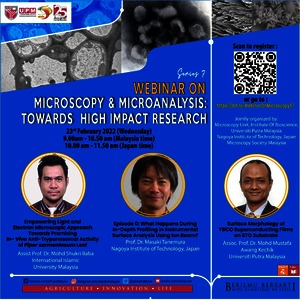Baba, Mohd Shukri
(2022)
Empowering light and electron microscopic approach towards promising in-vivo anti – trypanosomal activity of piper sarmentosum leaf.
In: Webinar on Microscopy & Microanalysis: Towards High Impact Research Series 7, 23 February 2022, Universiti Putra Malaysia.
(Unpublished)
Abstract
This study demonstrated how the manipulation of natural plant, Piper sarmentosum, promisingly can solve the endemicity of vector-borne zoonotic manifestation of atypical human trypanosomiasis (AHT) and Surra disease in livestock. The effectiveness of P. sarmentosum leaves on the growth and survival of the haemoflagellate protozoa T. evansi was compared with Berenil (C18H22N8O3). Groups of male ICR mice (6-8 weeks old, 25-30g body weight) were intraperitoneally (i.p) administered with the parasite at 5.0 × 103 T. evansi/mouse and orally given pre- and post-infection treatments with 0.2 mL of 10 mg/mL of P. sarmentosum-dH2O extract per mouse. Using Giemsa stained blood smear, microscopically, the development of parasite cells were assessed and the toxicity level of blood enzymes and selected vital organs and survival rate of the mice were also investigated. The morphological changes of T. evansi cells were evidenced and a positive correlation (p ≤ 0.05, n = 6) were recorded between the mice survival time and the ability to inhibit the parasites growth in pre-infection treatment group. Besides, the mice in PRE14 group (daily treated with P. sarmentosum-dH2O extract from 14 days before infection) was also recorded the longest pre-patent (42.71 ± 1.5 days) and survival (285.15 ± 3.6 days) period. The results for biochemical tests were significantly situated in the normal ranged level for all regimens as well as no abnormalities and injuries found on the selected vital organs. This study significantly evidenced that P. sarmentosum could be manipulated as a potential antiparasitic alternative drug towards T. evansi for the preservation and welfare of human and livestock beings.
Actions (login required)
 |
View Item |
![[img]](http://irep.iium.edu.my/96868/2.hassmallThumbnailVersion/seminar7.jpeg)



 Download Statistics
Download Statistics Download Statistics
Download Statistics